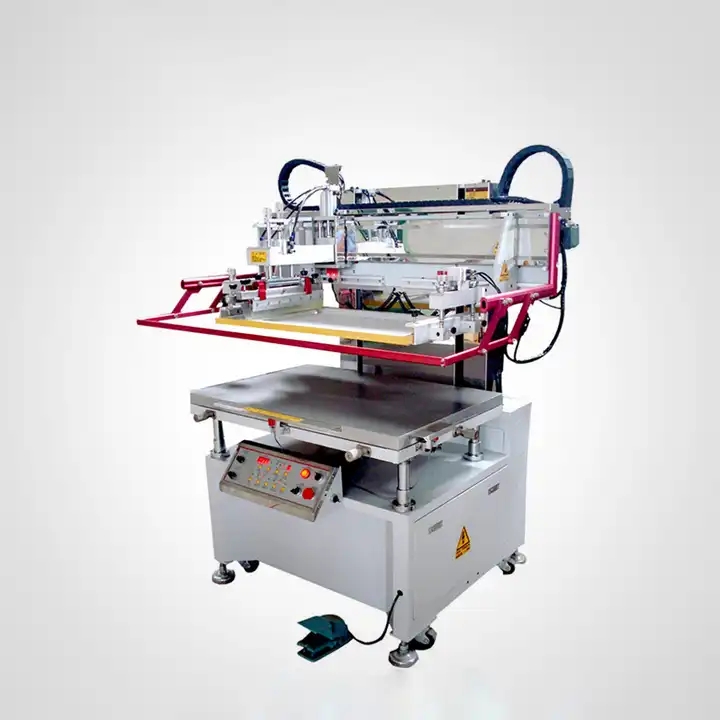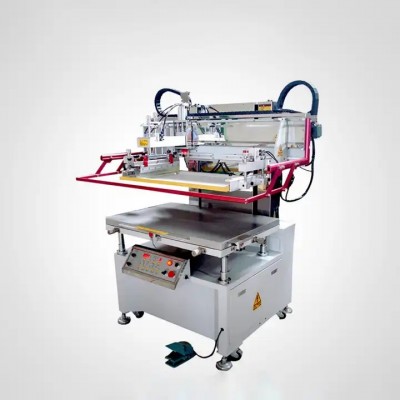Overview
Essential details
Plate Type:
Screen Printer
Condition:
New
Place of Origin:
Shandong, China
Brand Name:
XINFENG
Usage:
Bill Printer, Card Printer, Label Printer, Paper Printer
Automatic Grade:
Automatic
Color & Page:
single color
Voltage:
380
Dimensions(L*W*H):
1250*980*1620mm
Weight:
450KG
Certification:
ISO9001
Warranty:
4 years
After-sales Service Provided:
Field installation, commissioning and training, Overseas third-party support available
Supply Ability
Supply Ability
50 Piece/Pieces per Month
Packaging & delivery
Packaging Details
wooden case,Dimension 1250*980*1620mm,Weight:450kg,it is suitble by sea.
Port
Qingdao
Customer First Service First |
DEscriptION
We offer a wide range of pneumatically operated semi auto, flat printing machines, which are available in various sizes. This is a PLC controlled machine with various features for easy operations of machines. Along with table for quick registration, all the machines are equipped with festo cylinders and linear guides. The machines can print on metal, glass, wood, paper, plastics, membranes switch, PCB, DC card, advertisement materials, cloth etc.
Semi Automatic flat screen printing machine details: ConditionNewAutomatic GradeSemi AutomaticColor & PageSingle ColorVoltage380VGross Power2.1KWDimensions(L*W*H)1250*980*1620mmWeight450kgWarrantyone yearNameSemi Automatic flat screen printing machinePrinting area600*400mmMaximal frame900*650mmPrinting thickness30mmFlat Size700*500mmPaper Thickness100-350g/m2Print Motor1.5KwMax Print Speed1000s/hPrinting frequency1150HrOverprint accuracy0.01mmFlat precision+-0.05mmPrinting pressure0.6-0.8kg/square cmPayment & Shipping Terms: Minimum Order Quantity:1 Set/SetsPort:QingdaoPackaging Details:wooden case,Dimension 1250*980*1620mm,Weight:450kg,it is suitble by sea.Delivery Time:one weekPayment Terms:L/C,T/T,Supply Ability:100 Set/Sets per Month
Automatic screen printing machine application scope Widely used in the electronics appliances.advertising,packaging and printing,sports equipment,toys,stationery gifts,metal processing industries. l,Vertical structure
|
Customer First Service First |
Screen printing is a printing technique that uses a woven mesh to support an ink-blocking stencil. The attached stencil forms open areas of mesh that transfer ink or other printable materials which can be pressed through the mesh as a sharp-edged image onto a substrate. A fill blade or squeegee is moved across the screen stencil, forcing or pumping ink into the mesh openings for transfer by capillary action during the squeegee stroke.
Screen printing is also a stencil method of print making in which a design is imposed on a screen of polyester or other fine mesh, with blank areas coated with an impermeable substance, and ink is forced into the mesh openings of the mesh by the fill blade or squeegee and onto the printing surface during the squeegee stroke. It is also known as silkscreen,serigraphy, and serigraph printing. You can also have more than one colour printing, for example you could have a striped printing.
Printing technique
A screen is made of a piece of mesh stretched over a frame. A stencil is formed by blocking off parts of the screen in the negative image of the design to be printed; that is, the open spaces are where the ink will appear on the substrate.
Before printing occurs, the frame and screen must undergo the pre-press process, in which an emulsion is 'scooped' across the mesh and the 'exposure unit' burns away the unnecessary emulsion leaving behind a clean area in the mesh with the identical shape as the desired image. The surface (commonly referred to as a pallet) that the substrate will be printed against is coated with a wide 'pallet tape'. This serves to protect the 'pallet' from any unwanted ink leaking through the substrate and potentially staining the 'pallet' or transferring unwanted ink onto the next substrate. Next, the screen and frame are lined with a tape. The type of tape used in for this purpose often depends upon the ink that is to be printed onto the substrate. These aggressive tapes are generally used for UV and water-based inks due to the inks' lower viscosities. The last process in the 'pre-press' is blocking out any unwanted 'pin-holes' in the emulsion. If these holes are left in the emulsion, the ink will continue through and leave unwanted marks. To block out these holes, materials such as tapes, specialty emulsions and 'block-out pens' may be used effectively.
The screen is placed atop a substrate. Ink is placed on top of the screen, and a floodbar is used to push the ink through the holes in the mesh. The operator begins with the fill bar at the rear of the screen and behind a reservoir of ink. The operator lifts the screen to prevent contact with the substrate and then using a slight amount of downward force pulls the fill bar to the front of the screen. This effectively fills the mesh openings with ink and moves the ink reservoir to the front of the screen. The operator then uses a squeegee (rubber blade) to move the mesh down to the substrate and pushes the squeegee to the rear of the screen. The ink that is in the mesh opening is pumped or squeezed by capillary action to the substrate in a controlled and prescribed amount, i.e. the wet ink deposit is proportional to the thickness of the mesh and or stencil. As the squeegee moves toward the rear of the screen the tension of the mesh pulls the mesh up away from the substrate (called snap-off) leaving the ink upon the substrate surface.
There are three common types of screenprinting presses. The 'flat-bed', 'cylinder', and the most widely used type, the 'rotary'.
Textile items printed with multi-colour designs often use a wet on wet technique, or colors dried while on the press, while graphic items are allowed to dry between colours that are then printed with another screen and often in a different color after the product is re-aligned on the press.
Most screens are ready for recoating at this stage, but sometimes screens will have to undergo a further step in the reclaiming process called dehazing. This additional step removes haze or "ghost images" left behind in the screen once the emulsion has been removed. Ghost images tend to faintly outline the open areas of previous stencils, hence the name. They are the result of ink residue trapped in the mesh, often in the knuckles of the mesh (the points where threads cross).
While the public thinks of garments in conjunction with screenprinting, the technique is used on tens of thousands of items, including decals, clock and watch faces, balloons, and many other products. The technique has even been adapted for more advanced uses, such as laying down conductors and resistors in multi-layer circuits using thin ceramic layers as the substrate.
Versatility Screenprinting is more versatile than traditional printing techniques. The surface does not have to be printed under pressure, unlike etching or lithography, and it does not have to be planar. Different inks can be used to work with a variety of materials, such as textiles, ceramics, wood, paper, glass, metal, and plastic. As a result, screenprinting is used in many different industries, including: Balloons Clothing Decals Medical devices Printed electronics, including circuit board printing Product labels Signs and displays Snowboard graphics Textile fabric Thick film technology
Screen printing press To print multiple copies of the screen design on garments in an efficient manner, amateur and professional printers usually use a screen printing press. Many companies offer simple to sophisticated printing presses. Most of these presses are manual. A few that are industrial-grade-automatic printers require minimal manual labor and increase production significantly.
Analysis of screen printing trends and prospects
screen printing market space
China from the 20th century, 80 years, the speed of screen printing materials, equipment, technology research and development, so that screen-printing with flexo printing, offset printing, gravure played an advantage in competition. Rate of 7% annual increase. Currently there are about More than 70% of the wide format color screen printing with spot-color printing, nearly 30% using four-color overprint, and the proportion of four-color overprint is still increasing steadily. Industry survey showed that 70% of the annual output value of enterprises 100 million. But China's current total output value of the printing screen printing production value less than 2%, which have great potential to be tapped and broad development prospects.
Survey, the national screen printing ink usage is 2-year million tons, of which about 54% of the imported products; mesh year with about 10 million meters, of which about 62% of the imported silk screen, light-sensitive plastic consumption is about 4300 years tons, of which about 57% of imported products. The more large-scale screen printing factories in the greater proportion of imported products.
The next screen printing will remain a high growth rate will gradually increase the technical, industrial scale will be further expanded. Authorities predicted that the future world production of screen printing in the printing share of GDP will rise to 10%. There is no doubt that China Screen Printing Industry is being nurtured the development of a larger space and potential market. Expected that by 2005 China will become the world's largest screen printing market. China screen printing in the future will be depth and breadth. "Deep" is to a higher level of development, international screen printing industry has long been widely used in computer design, plate making, carving and other advanced electronic technology, and our country for these new technologies are still in the research trial stage; "well" is the development of new screen printing products, such as outdoor advertising and other large-scale screen printing.
screen printing applications
Survey shows that China Screen Printing Industry and the number of kinds of products sorted by manufacturers as follows:signs and panels, textiles and garments, plastic sheets, advertising materials, printed circuits, light boxes and so on.Emerging field of screen printing to an extraordinary rate, such as building materials, the system card, CD-ROM, security printing and so on.
|





